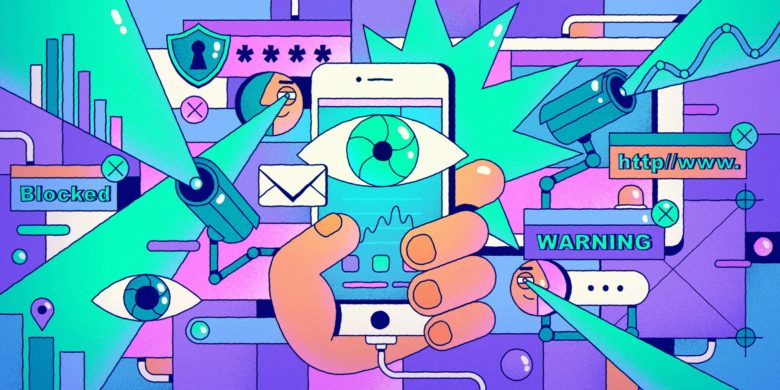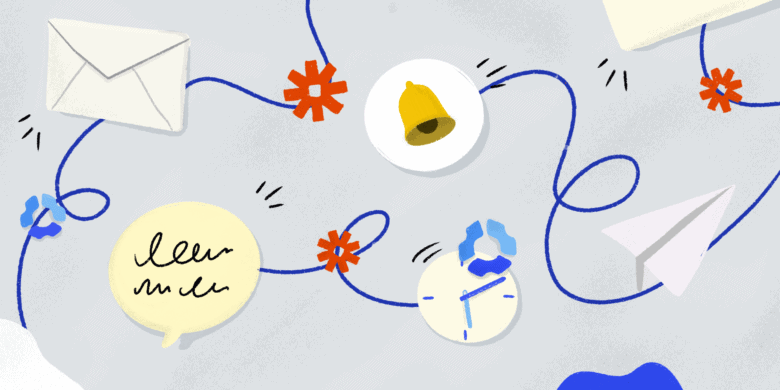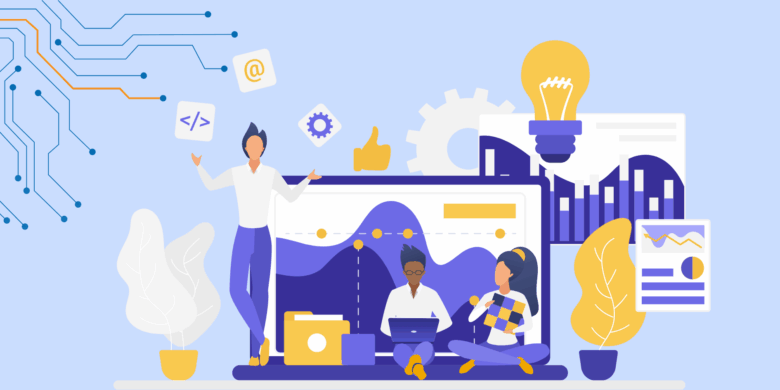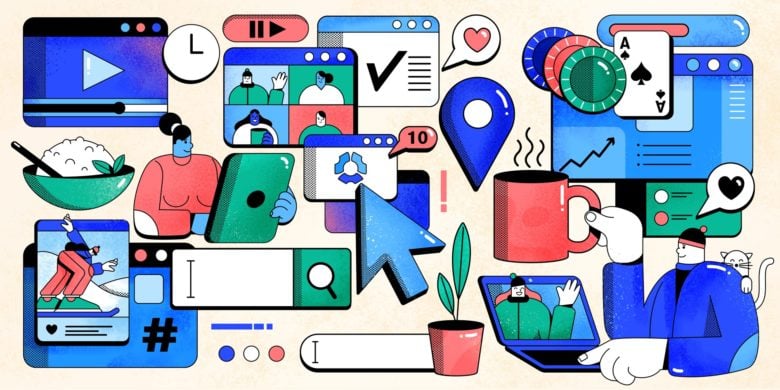When I moderated this AI productivity panel, I expected a solid conversation. What I didn’t expect was the flood of real-world insights, vulnerable truths, and practical advice that would follow.
At Hubstaff, we’ve seen firsthand how AI can accelerate productivity, but we also know it doesn’t happen by magic. During our AI Productivity Shift panel, I had the chance to speak with four brilliant minds leading the charge on AI, remote work, and organizational change:
- Dr. Gleb Tsipursky – Cognitive scientist and remote work expert
- Eryn Peters – Co-founder, AI Maturity Index
- Nadia Harris – Founder, Remote Work Advocate
- Phil Kirschner – Workplace strategist and former McKinsey & WeWork exec
Together, we unpacked what’s working, what’s not, and how to lead smarter, faster, and more human-first with AI. Here’s a recap of what stood out and what you can act on right now.
Prefer to watch? Before we dig into the takeaways, you can catch the full panel conversation here.
Want the full data behind this conversation? Download the AI Productivity Shift report to explore the stats, trends, and insights shaping how teams are using AI at work.
Stay in the loop
Subscribe to our blog for the latest remote work insights and productivity tips.
1. The usage gap is real, and it’s not a tech problem
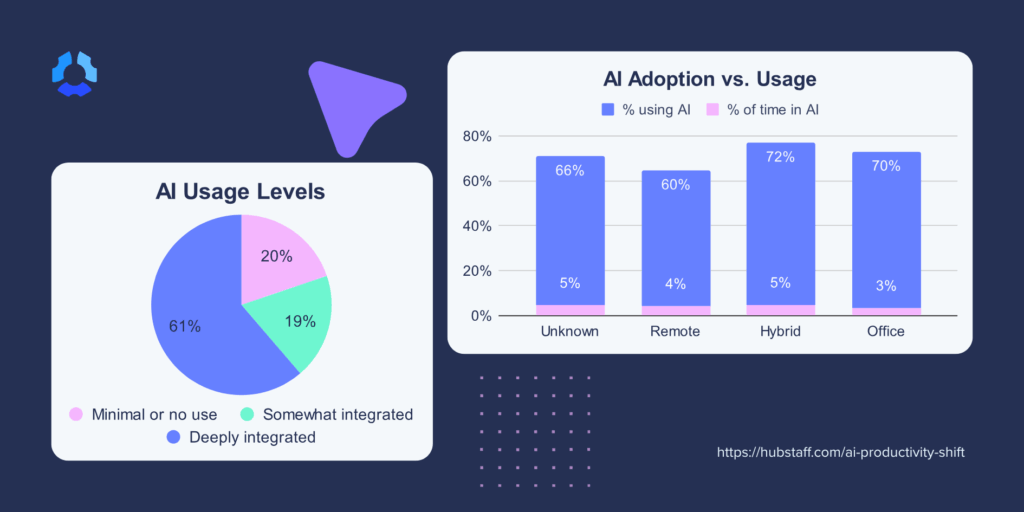
One of the headline stats from our research: 85% of professionals say they’re using AI, but only 4% of their actual time is spent using it. That’s a massive disconnect.
As Dr. Gleb put it, the issue isn’t access, it’s awareness. Most people don’t know they can switch models in ChatGPT or create custom copilots trained on internal templates. They’re poking around in the dark without a flashlight.
And as Nadia added, governance and compliance fears (especially in regulated regions like the EU) are making companies hesitant to go deeper. They’re unsure about how data is stored, who has access, and what’s truly compliant.
Takeaway: Start with education. Train your team in practical use cases. And build confidence with clear, role-based AI usage policies that include real examples of what’s encouraged and what’s not.
2. Fear is the quiet killer of innovation
One thing that really struck me: fear is doing more damage than we realize.
Eryn spoke about how companies send mixed messages, first warning employees not to use AI, then flipping to say everyone should adopt it. That kind of whiplash leads to confusion and resistance. Phil added a truth I hadn’t considered before: some employees don’t want to share their AI workflows because it reveals too much about how they work, or what they’re automating and augmenting.
It’s a visibility problem and a psychological safety problem.
Takeaway: Foster a culture of curiosity. Celebrate experimentation. Make AI visible, not secret. One way to start? Run an “AI Week” challenge internally where teams present how they’re using AI to improve workflows.
3. Embedding AI into workflows unlocks real impact
This was my favorite part of the panel, when real examples came to life.
Nadia shared how she helped a startup consolidate scattered data from multiple tools and automate core business processes using AI. The result? Massive time savings and clearer focus across teams.
Eryn talked about a small consulting firm that built custom agents to automate competitive analysis. What used to take weeks now takes hours, and they’re closing deals that once felt out of reach.
Takeaway: Don’t start with “AI use cases.” Start with broken workflows. Where are your teams drowning in manual tasks or research-heavy processes? That’s your AI opportunity.
4. Let your team lead
I was really inspired by how Dr. Gleb’s approach flips the usual narrative. Instead of mandating one AI tool or workflow, he trains teams on how to use AI effectively and lets them build their own copilots.
At one insurance company, claims agents created their own Copilot agents to automate policy letters. Management picked the best one, scaled it, and got massive time savings across the board.
Takeaway: Enable your team to build what works for them. Give everyone foundational training, encourage exploration, and let the best ideas surface organically. That’s how innovation scales.
5. AI is forcing us to redefine productivity
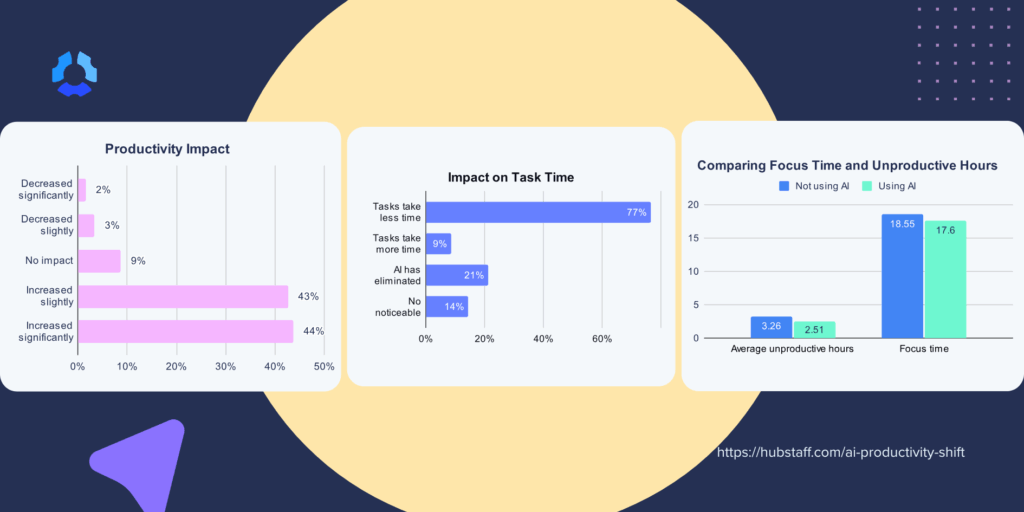
Here’s where things got real. We shared some striking stats from our survey:
- 77% of people say AI reduces task time
- 70% say it increases focus
- 45% report a significant boost in productivity
But what does “productivity” even mean anymore?
Nadia challenged the idea that staying late at the office = productivity. It’s not about visible effort, it’s about meaningful outcomes. Phil emphasized that AI should give us more time to focus on the right things, not just more things. And Dr. Gleb cautioned that AI is, in fact, increasing workload, so the bar is rising whether we like it or not.
Takeaway: Shift your metrics. Move from measuring activity to measuring outcomes, speed, and effectiveness. Don’t punish employees for using AI to work smarter.
6. Hiring, training, and salaries are all changing fast

One stat that caught everyone’s attention: 20% of companies are already adjusting salaries based on AI skills.
Eryn called out the need to rethink hiring entirely. The half-life of skills is shrinking, so we can’t just look at job titles and degrees anymore. We need to value lifelong learners, curiosity, and adaptability.
And as Dr. Gleb showed, companies need clear policies that state AI is meant to augment not replace people. That builds trust and drives smarter adoption.
Takeaway:
- Add AI fluency to performance reviews and hiring conversations
- Reward experimentation and adaptability
- Create policies that empower, not police
7. Why small teams move fast and how big ones can catch up
Small teams are winning with AI because they can act fast, take risks, and course-correct quickly. Phil described the cultural gap perfectly: in startups, “move fast and break things” is encouraged. In large enterprises, “take a risk and you’ll get fired” is the unspoken rule.
But big companies aren’t doomed. Eryn pointed to Accenture’s internal AI app marketplace as a great example of balancing control with empowerment.
Takeaway: Create your own internal AI marketplace or sandbox. Give employees an approved way to experiment and share tools without triggering months of red tape.
8. What AI will change for each of us next year
We closed the session by asking: What’s one way AI will impact your work in the next 12 months?
Here’s what the panelists said:
- Phil is using AI to support personal writing projects and automate email workflows
- Nadia is using AI to spot compliance patterns across companies and create faster audits
- Eryn is shifting from “creator” to “curator,” cutting through the noise to surface valuable insights
- Dr. Gleb is using AI tools to teach himself, learn platform updates, and tailor learning to his clients’ use cases
As for me? I’m focused on creating space for these conversations to keep happening because AI is only as powerful as the people driving it.
Takeaway: Ask yourself what one area of your work could be faster, easier, or smarter with AI? Start there.
Final thoughts: AI’s true value comes from people
Moderating this panel reminded me of something simple but powerful: AI works best when we keep it human.
Train your teams. Build curiosity. Focus on outcomes. Automate what doesn’t matter and protect what does. The teams that win won’t just use AI. They’ll use it well.
Thanks again to our panelists, our audience, and to everyone trying to lead this shift with intention and heart.
Let’s build smarter together.
Prefer to watch? Before we dig into the takeaways, you can catch the full panel conversation here.
Want the full data behind this conversation? Download the AI Productivity Shift report to explore the stats, trends, and insights shaping how teams are using AI at work.
Most popular
6 Signs Your Employees Can Tell They’re Being Monitored at Work
Noticing unfamiliar software, restricted access, or slower internet? These might be signs you are being monitored at work. I...
The Complete Guide to User Activity Monitoring: Tools, Benefits, and Ethics
Have you ever noticed how the conversation around monitoring tends to swing between “track everything” and “trust everyone b...
How to Choose the Right Employee Attendance Tracker for Your Team
An employee attendance tracker records time spent on the job, absences, late or abandoned shifts, and other valuable information....
How Agencies Can Leverage AI & Time Tracking to Increase Profits
Why AI Is Powering Agencies, But It’s Missing From the Data Agencies are adopting AI faster than ever – using it for research,...

